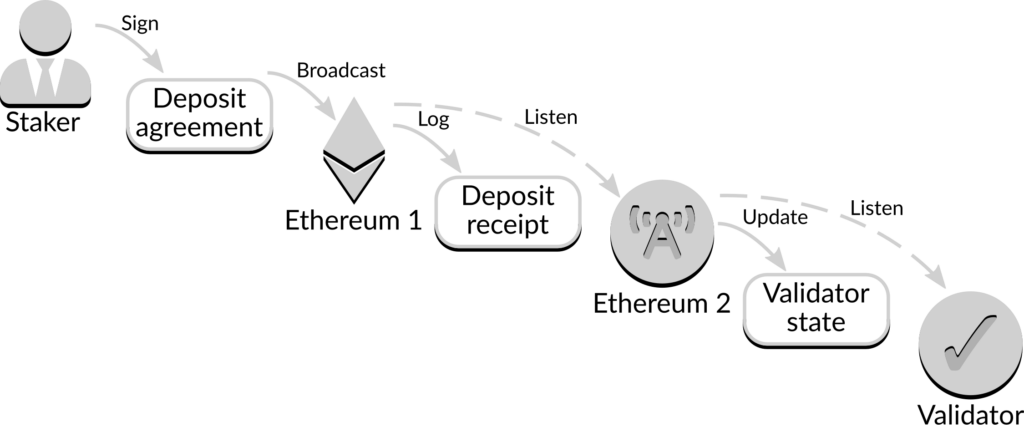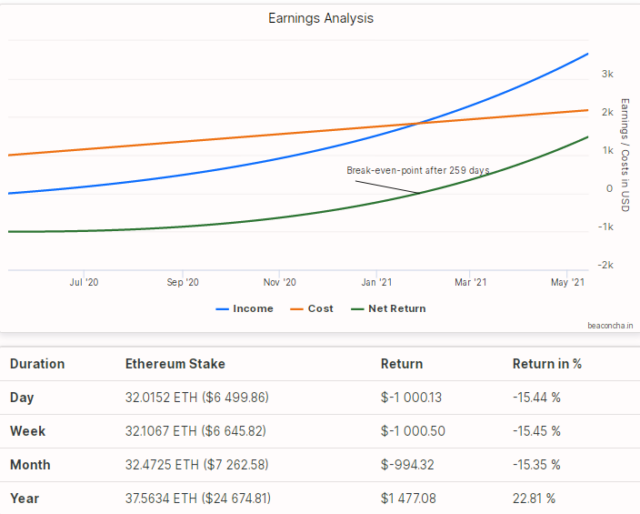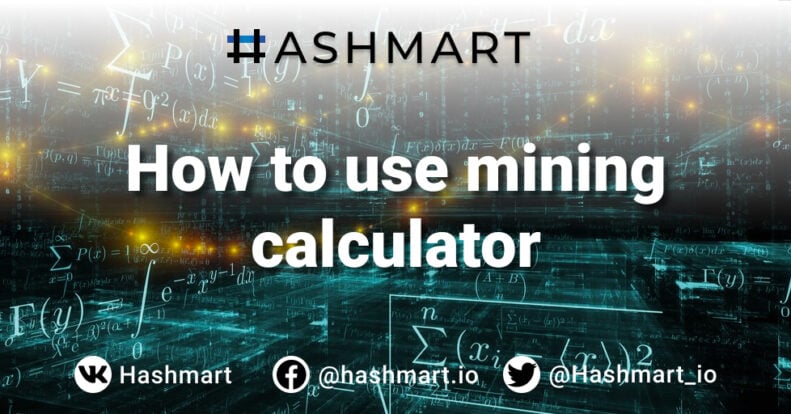How much you can earn with Ethereum’s collective staking in 2022

The Ethereum network is currently overloaded, causing transaction fees to skyrocket to exorbitant levels for many users. This is partly due to the success of DeFi projects, where customers are willing to pay high transaction fees because of their enormous financial value. To solve all these problems, the Ethereum Foundation is working on Ethereum 2.0 (Eth2), a network upgrade that will improve the security, speed, efficiency, and scalability of the project. Today we will look at the pros and cons of earning from the new altcoin protocol, as well as understand the intricacies of staking.
What is Ethereum Stacking?
Proof-of-stake (PoS) is a mechanism that blockchain networks use to achieve consensus. Staking is a process used by PoS blockchains to protect the blockchain and create new blocks. Staking is done by validators who validate transactions and add blocks to the blockchain. In the case of Ethereum, validators should replace Ethereum mining after the final transition to Ethereum 2.0.
What is Ethereum 2.0? It is the second version of the cryptocurrency protocol, the launch of which was planned by the developers of Ethereum several years ago. In its current state, Ethereum cannot provide high bandwidth, i.e. the altcoin network processes only a few dozens of transactions per second. With the transition to Proof-of-Stake, this should increase to several thousand transactions per second.
To become a validator in the network, users must stake their Ether (ETH), the native cryptocurrency of the Ethereum blockchain. Validators, like miners in Proof-of-Work (PoW), are responsible for organizing transactions and creating new blocks so that all nodes can agree on the state of the network. The minimum amount to accept a validator is 32 ETH or about $77,000.
The coins blocked in the smart contract also serve as a tool to incentivize positive validator activity. For example, a user could lose a portion of his share if he leaves the network (fails to pass validation), or lose his entire investment if he conspires deliberately with other validators to undermine the performance of the cryptocurrency.
How does staking work?
A PoS-based blockchain, unlike a PoW-based blockchain, aggregates 32 blocks of transactions during each round of verification, which lasts on average 6.4 minutes. Each such group of blocks is called an epoch. When the blockchain adds two new epochs, the process is considered irreversible and fully complete.
The upgrade, called the Beacon Chain, divides the staking participants into “committees” of 128 people and randomly assigns them to a specific group of blocks (a shard). Each committee is assigned a slot and has a certain amount of time to propose a new block and check internal transactions. Each epoch has 32 slots, requiring 32 sets of committees to complete the verification process. Once a committee is assigned to a block, one random member is given the exclusive right to propose a new block of transactions. The remaining 127 members vote on the proposal and confirm the transactions. The Beacon Chain also collects information about the state of each shard and distributes it to neighboring shards, keeping the network in sync. Thus, all validator activity in the new protocol will be governed by the principles established by this upgrade.
Once a new block is added to the blockchain, a “cross-reference” is generated for authentication and validation by the majority of the committee members. Only then is the validator chosen to offer the new block their reward. A block is “completed” if at least two-thirds of the validators agree with its state. If validators try to undo this process later with a 51 attack, they will lose all of their coins locked in the smart contract for staking.
Staking profitability
ETH 2.0 uses annual interest rates and an inverse square root function to calculate its rewards. In other words, this means that the lower the total number of blocked ETH validators, the lower the reward for each individual validator will be.
The reward models for offering blocks and confirming blocks are different. The block proposer receives one-eighth of the base reward, known as B, while the validator receives the remaining seven-eighths of B, which is adjusted depending on how long it takes the block proposer to submit his validation.
To receive the full award, the certifier must submit a block as soon as possible. The fee is reduced for each slot that passes without an attestation, including the attestation to the block. The reward is reduced by 7/16 B if two slots are passed before attestation is included, by 7/32 B if three slots are passed, and so on.
The rate of coin emission in Ethereum 2.0 is largely determined by the base reward. The lower the base fee per validator, the higher the number of validators connected to Ethereum 2.0. This is so because base pay is inversely proportional to the square root of the total balance of all Eth 2.0 validators. Overall, the average investor can expect an annual return of 6 to 15 percent on their investment. That is, with an investment of $10,000, you can get up to $1,500 in profit by the end of the year!
How to invest in Hashmart?
Recently, cloud mining platform Hashmart has been offering its users the opportunity to participate in Ethereum staking with less than 32 ETH of starting capital. The principle of profit calculation, in this case, is as simple as possible – you get rewarded for Ethereum stacking in proportion to the share of coins you invested.
From all blocked ETH of our clients, a common pool is formed, which is sent to the smart contract. Thus, cryptocurrency is available for investment even for those who have only 0.1 ETH in their account. Hashmart will soon add a staking calculator to more accurately calculate estimated returns.
Please note that you can get your coins back only after the final launch of the Ethereum 2.0 network. This is a prerequisite not for our platform, but in general for all participants of the project. The logic here is simple – at the start of the new network it will immediately need validators, so the developers needed to create a mechanism that would encourage more users to stay to participate in the process.
What are the risks of investing in Ethereum 2.0? The main problem for an investor is a falling ETH price (which is happening in the market right now). However, such an investment can also be seen as a long-term investment. Given the hype around the second version of the protocol, by its final launch, the value of Ethereum is very likely to increase, because after seeing the developers’ first successes in this field, other investors will also want to take part in the stacking. And in order to participate, as you already know, you have to buy Ethereum. By the way, on Hashmart you can do it directly, i.e. with a bank card, without resorting to other intermediaries.
Staking vs. regular cryptocurrency investment
If staking is so profitable in the long run, why isn’t absolutely everyone using it? The fact is that there are plenty of other uses for Ethereum coins, such as direct investments in decentralized finance protocols. Besides, some people don’t realize all the benefits of staking or are afraid of another postponement of Ethereum 2.0 network launch. This has happened more than once in the past.
And yet, given the expected annual yield of staking, the usual purchase of Ethereum and holding coins in a wallet loses out to an investment in Ethereum 2.0. For example, if you count on Ethereum appreciation and buy cryptocurrency, you also get extra income thanks to staking. Yes, the coins will have to be locked in a smart contract for a long time, but with a regular long-term investment, they also lie idle in your wallet for a long time.
Now that you know all the benefits of staking, it’s time to start earning from it! Sign up on our website, read Hashmart reviews and go to your personal account to invest your ETH in the future of the project.





